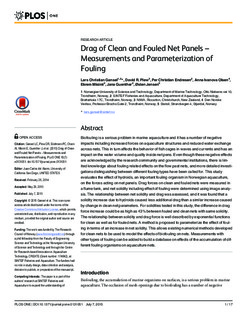| dc.contributor.author | Gansel, Lars | |
| dc.contributor.author | Plew, David R. | |
| dc.contributor.author | Endresen, Per Christian | |
| dc.contributor.author | Ivanova, Anna | |
| dc.contributor.author | Misimi, Ekrem | |
| dc.contributor.author | Günther, Jana | |
| dc.contributor.author | Jensen, Østen | |
| dc.date.accessioned | 2019-02-15T20:09:14Z | |
| dc.date.available | 2019-02-15T20:09:14Z | |
| dc.date.created | 2015-07-13T23:29:38Z | |
| dc.date.issued | 2015-07-07 | |
| dc.identifier.citation | PLoS ONE 10(7): | nb_NO |
| dc.identifier.issn | 1932-6203 | |
| dc.identifier.uri | http://hdl.handle.net/11250/2585778 | |
| dc.description.abstract | Biofouling is a serious problem in marine aquaculture and it has a number of negative impacts including increased forces on aquaculture structures and reduced water exchange across nets. This in turn affects the behavior of fish cages in waves and currents and has an impact on the water volume and quality inside net pens. Even though these negative effects are acknowledged by the research community and governmental institutions, there is limited knowledge about fouling related effects on the flow past nets, and more detailed investigations distinguishing between different fouling types have been called for. This study evaluates the effect of hydroids, an important fouling organism in Norwegian aquaculture, on the forces acting on net panels. Drag forces on clean and fouled nets were measured in a flume tank, and net solidity including effect of fouling were determined using image analysis. The relationship between net solidity and drag was assessed, and it was found that a solidity increase due to hydroids caused less additional drag than a similar increase caused by change in clean net parameters. For solidities tested in this study, the difference in drag force increase could be as high as 43% between fouled and clean nets with same solidity. The relationship between solidity and drag force is well described by exponential functions for clean as well as for fouled nets. A method is proposed to parameterize the effect of fouling in terms of an increase in net solidity. This allows existing numerical methods developed for clean nets to be used to model the effects of biofouling on nets. Measurements with other types of fouling can be added to build a database on effects of the accumulation of different fouling organisms on aquaculture nets. | nb_NO |
| dc.language.iso | eng | nb_NO |
| dc.rights | Navngivelse 4.0 Internasjonal | * |
| dc.rights.uri | http://creativecommons.org/licenses/by/4.0/deed.no | * |
| dc.title | Drag of Clean and Fouled Net Panels – Measurements and Parameterization of Fouling | nb_NO |
| dc.type | Journal article | nb_NO |
| dc.type | Peer reviewed | nb_NO |
| dc.description.version | publishedVersion | nb_NO |
| dc.rights.holder | Copyright: © 2015 Gansel et al. This is an open access article distributed under the terms of the Creative Commons Attribution License, which permits unrestricted use, distribution, and reproduction in any medium, provided the original author and source are credited | nb_NO |
| dc.source.journal | PLoS ONE | nb_NO |
| dc.identifier.doi | 10.1371/journal.pone.0131051 | |
| dc.identifier.cristin | 1253777 | |
| cristin.unitcode | 7566,2,0,0 | |
| cristin.unitname | Sjømatteknologi | |
| cristin.ispublished | true | |
| cristin.fulltext | original | |
| cristin.qualitycode | 1 | |

